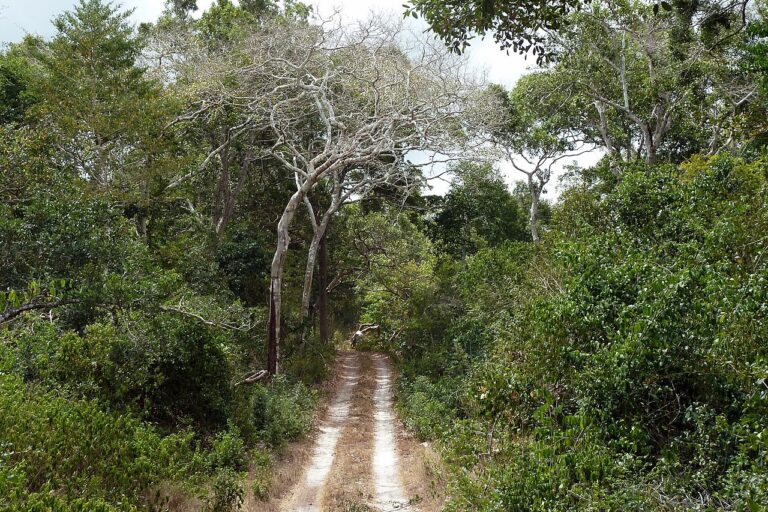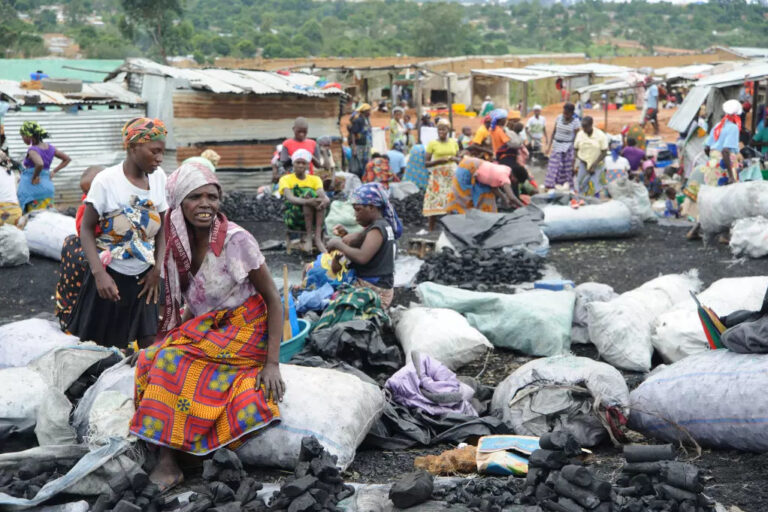Ghanaian scientists are cultivating seedlings of two critically endangered tree species while searching forests across the country for surviving Talbotiella gentii and Aubregrinia taiensis in the wild.Women in Kenya’s Kilifi County are planting trees from which to produce herbal medicines and supplements; they say their efforts help protect local forests.Commercial charcoal producers have led the destruction of more than 300,000 hectares (741,000 acres) of forest in Angola’s Huambo province since 2000.Forests & Finance is Mongabay’s bi-weekly bulletin of news from Africa’s forests. Ghanaian researchers diligently working to save two endangered tree species
Ghanaian scientists are cultivating seedlings of two critically endangered tree species while searching forests across the country for surviving Talbotiella gentii and Aubregrinia taiensis in the wild.
T. gentii, an evergreen with a thick trunk and a dense spreading crown that produces sweet-smelling pale pink flowers, was once common in the dry forest zones of southwestern Ghana. As forests here have been cut down for agriculture, isolated patches of this tree are now found only in forest reserves at Bandai Hills and Yongwa.
A. taiensis, also known as the great tiger-nut tree or duatadwe kese in the Akan language, whose buttressed trunk can grow up to 50 meters (164 feet) tall, was previously found across forested zones in southern Ghana and Cote d’Ivoire. The only known wild specimens today are in Ghana’s Bia Tano Forest Reserve.
Aubregrinia taiensis. Image courtesy Paris, Muséum National d’Histoire Naturelle via Wikicommons (CC BY 4.0)
James Amponsah, a research scientist at the Forestry Research Institute of Ghana (FORIG), a division of the Council for Scientific and Industrial Research Ghana, told Mongabay that agriculture, illegal logging and rapidly expanding illegal mining are the leading threats to both tree species and the forests they thrive in.
“Regarding the Aubregrinia taiensis, what makes the situation a bit serious is that, from the year 2019, we have been doing an extensive survey in the forest reserves of Ghana and we have only found 16 trees, and about seven of them are not matured. So the problem is that if we don’t take steps to save it, in the next 10 or 15 years our children will only hear about the name but will never see the tree.”
FORIG is managing natural regeneration of the handful of duatadwe kese surviving in the wild in protected forests at Wurobong and Bia Tano. Amponsah said the institute has also established conservation plots for the species in the Tano and Mpraeso forests and at a research plot FORIG maintains in Kumasi.
He said 45 seedlings are being nurtured at these three sites, and the Forestry Research Institute has received funding to expand the restoration project and it is considering planting another 150 seedlings.
The Ghana Wildlife Society began planting T. gentii seedlings in selected forest reserves in 2018. Kwame Boafo, a wildlife society project officer, said around 50,000 seedlings have since been at the Bandai Hills Forest Reserve, Yongwa and Volta Block, all in the southern part of the country.
He said while some seedlings have died after being sprayed with herbicides and other agro-chemicals by people illegally farming inside these reserves, the survival rate is between 80 and 90 percent.
 A road in Kenya’s Arabuko Sokoke Forest Reserve. Image by Николай Максимович via Wikicommons (CC BY 3.0)
A road in Kenya’s Arabuko Sokoke Forest Reserve. Image by Николай Максимович via Wikicommons (CC BY 3.0)
Women take the lead in non-consumptive forest use in Kenya’s Kilifi county
Every week, the women of the Ufanisi Conservation Group gather to tend seedlings and young trees in and around their homes in the village of Malimboni, in Kenya’s Kilifi county. Sometimes they walk into the Arabuko Sokoke Forest Reserve, 2 km (1.2 mi) away to collect seedlings of indigenous species.
“We also plant fruit trees in our homestead,” group leader Salome Jumwa told Mongabay. “I have 5 acres of land that I have planted in my homestead, and other members also have planted different trees in their homesteads. My land now provides a place for communal learning, especially for both local and foreign students who visit.”
The group has permission from the Kenya Forest Service to gather indigenous tree seedlings from the nearby forest reserve, the largest coastal forest remaining in East Africa.
“We are licensed to enter Arabuko Sokoke Forest and this means that we are escorted by Kenya Forest Service rangers to look for indigenous seedlings,” said Jumwa.
The group has planted more than 130 indigenous tree species across almost 8 hectares (20 acres) of land in total around Majimboni. Ufanisi’s members focus on growing trees with medicinal uses, making traditional nutritional supplements, remedies for reproductive health problems and more out of the roots, bark and other parts of trees.
Jumwa said most of the group’s members are women because unlike men here, they have the patience to nurture trees from seedlings until maturity.
“This work needs a person who endures because it takes time for trees to mature. When men are called in to attend forums, they do sometimes attend, but when they are told to take care of the trees from nursery stage to maturity, it’s hard for them. We have only 21 members; men are five, while women are 16.”
The Ufanisi Conservation Group sets an example for others, beginning to restore tree cover on farms and family compounds. Their work also shows ways to benefit from forests other than cutting trees down for fuel or timber.
 Women selling charcoal at the German market on the outskirts of Huambo, Angola. Image by Guy Olivier/IRIN
Women selling charcoal at the German market on the outskirts of Huambo, Angola. Image by Guy Olivier/IRIN
More than 300,000 hectares of forest lost in Angola’s Huambo province since 2000
Researchers from the José Eduardo dos Santos University (Angola) and the University of Córdoba (Spain) analyzed representative sample plots across the province using satellite images and found that 359,000 hectares (887,000 acres) — 13% — of forest in Angola’s Huambo province have been lost in the past two decades. The researchers said charcoal production, felling of timber for fuel or construction and unregulated burning and clearing of Huambo’s miombo woodland forests for agriculture are the factors responsible for this startling loss.
In 2000, forests covered 2.7 million hectares (6.7 million acres) of this central Angolan province. But production of charcoal is an increasingly important economic activity in Huambo.
“Rural populations, who make their living from exploiting natural resources, rely on this income for their survival,” said study co-author Luís Manuel Miapia, who works in the Forest Engineering and Agricultural Sciences department at José Eduardo dos Santos University.
As a rule, the researchers say, charcoal producers should limit themselves to cutting down no more than 24 trees per hectare, but in many places, charcoalers are exceeding this figure. In the municipality of Caála, available records indicate the felling of up to 31 trees per hectare; analysis of satellite data showed this district lost just over 20% of its forest cover.
They noted that Caála, like the other municipal areas showing the greatest forest loss, is close to the main roads leading to the Angolan capital, Luanda, and the country’s principal port, Benguela. Areas farther from these trade routes, like the provincial capital, Huambo, showed the least deforestation.
To reverse this situation, Miapia says that alternative income-generating projects, especially ones that benefit young people in these communities are needed. This, he said, would help to reduce demand for firewood and the production of charcoal.
Antónia Gonçalo, Awudu Salami, and Diana Wanyonyi contributed to this bulletin.
Fires threaten Afromontane forests’ ‘whole new world’: Q&A with Martim Melo
Citation
Miapia, L. M., Ariza-Mateos, D., Lacerda-Quartín, V., & Palacios-Rodríguez, G. (2021). Deforestation and biomass production in miombo forest in Huambo (Angola): A balance between local and global needs. Forests, 12(11), 1557. doi:10.3390/f12111557
FEEDBACK: Use this form to send a message to the author of this post. If you want to post a public comment, you can do that at the bottom of the page.
charcoal, Community Forests, Community-based Conservation, Conservation, Critically Endangered Species, Deforestation, Drivers Of Deforestation, Environment, Forests, Logging, Timber, timber trade, Trade, Tropical Deforestation, Tropical Forests
Africa, Angola, Central Africa, East Africa, Ghana, Kenya, Southern Africa
Source link : https://news.mongabay.com/2023/07/forests-finance-fears-for-forests-in-angola-flashes-of-hope-from-kenya-ghana/
Author :
Publish date : 2023-07-31 07:00:00
Copyright for syndicated content belongs to the linked Source.





